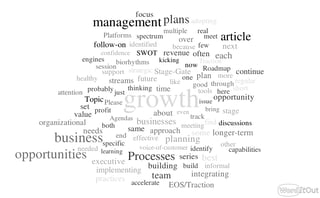Growth Insights for CEOs

Outsider Insights | From Hustle to System: Why More CEOs Are Rebuilding Their Sales Function
Outsider Insights
Across Chief Outsiders, we talk to hundreds of CEOs every month. In this new series, we explore the trends and challenges we’re hearing from these discussions – and what you can do if you’re facing the same issues in your business.
Recent Posts

Three Reasons Why A One Page Marketing Plan Will Keep Your Growth Strategy on Course
Thu, Jun 7, 2018 — If you type in “marketing strategy” on Google, your screen will instantly become flooded with a spectrum of software tools and new-age philosophies. With all the information available to us at the click of a button, defining and implementing the right strategic plan for your business can become time-consuming – and overwhelming.

The Top 12 Internet Trends Executives Should Know About in 2018
Wed, Jun 6, 2018 — For business executives, staying relevant in this time of innovation and rapid technological advancement can be challenging. Thankfully, we can leverage consumer and marketplace data to help our companies optimize products and services. One of the premier analytical reports on emerging business-related trends, Mary Meeker’s annual Internet Trends 2018, was just released. While the more than 290 slides in the full report come packed with useful information for driving your company forward, here are 12 important and actionable insights for business executives.

CMO or Chief Growth Officer?
Mon, Jun 4, 2018 — CMOs continue to calibrate their role in the executive suite as the scope of marketing has kept growing. In addition to the traditional fields of branding, demand generation and market research, it now includes many digital workloads, sales enablement, customer experience and retention and often strategy.
Stay up-to-date with the latest from Chief Outsiders

How People and Organizational Capabilities Sustain Business Growth
Thu, May 31, 2018 — If you have been following this series of articles on sustainable business growth, you know that we have arrived at our third topic. The first article introduced the difference between a growth plan (singular event) and a growth engine (recurring system). The theme we developed in that piece supported the need to go beyond growth plans to create sustained growth performance. Our argument that while growth plans are good, growth engines are better.

Beyond the Latest Tech: Four Essentials to Leading the New Workforce
Wed, May 23, 2018 — Let’s play a quick game of word association. When I say, “remote worker,” what comes to mind? Is it a 20-something creative-type sipping on a Starbucks latte? How about a global team videoconferencing in real-time? Yes, it’s easy to conjure up a stylized version of an offsite freelancer or employee, because the interest in (and need for) remote, fractional, and temporary work is growing at a breakneck pace. Because today’s most talented employees prefer the flexibility and quality of life that the new way of working provides, leading enterprises and emerging businesses alike are adopting flexible policies to embrace the new normal.

How Healthy Business Management Processes Sustain Business Growth
Tue, May 15, 2018 — In our first blog of the series, we defined the difference between a growth plan and a growth engine. In that discussion, we defined a growth plan as a singular event that identify future revenue and profit streams and identify capabilities, assets, and competencies the business needs to build to take advantage of future growth opportunities. As we define it however, a growth engine is not an event or a document or a plan, a growth engine is a system of integrated and replicable growth focused processes that support and enable sustained growth performance over a number of years. That blog included a brief questionnaire that helped you assess your company's ability to put a growth engine in place.

The Role of Processes in Digital Growth for Small- and Mid-Sized Businesses (SMBs)
Mon, May 14, 2018 — This is the second in a series of articles on helping executives in small- and mid-sized businesses utilize digital technologies effectively to assist in accelerating revenues and profits. The previous article included an introduction to four major ways digital technologies can help your business, described a spectrum of technologies and a possible implementation roadmap, and associated digital proficiency with enhanced business performance. It also included a 10-question survey to help you set an internal benchmark for your digital programs. In this article, I’ll provide practical guidance on where to start a journey for those businesses with a minimal digital growth path today.

A CEO’s Guide to Marketing ROI
Wed, May 2, 2018 — The old John Wanamaker quote from 100 years ago still rings true today for many CEOs: “Half the money I spend on advertising is wasted; the trouble is, I don’t which half.” While we have made amazing advancements in marketing, in some circles, accountability is not among them. Are you happy with the financial documentation being provided to you on marketing effort ROI? If the answer is “no,” you share a common pain point that many CEOs we work with share with us when we first sit down with them. The good news? This is a pain point that can be addressed in a relatively quick manner -- in many instances, within 90 days. If you haven’t been given one before, a “marketing-return-on investment-roadmap” is a great way to visually gauge what you’d like to see changed within your marketing structure.

How Your Executive Team Can Sustain Your Business Growth through Best Practices
Tue, May 1, 2018 — If you don’t believe that consistent, profitable business growth is a need of virtually every small- and mid-sized business, and especially for yours, you probably won’t get value from this article. The real challenges aren’t understanding the value of growth to your business--they are about determining where your best growth opportunities are, prioritizing across multiple potential growth opportunities, integrating both shorter- and longer-term growth opportunities into your management processes, and organizing for success and building an ability to tap into new revenue streams consistently and over multiple years.
.png?width=1500&height=398&name=CO_Corporate%20Logo%202021_4C_HOR_FNL-1%20(1).png)